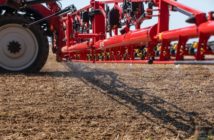Arable farmers should consider applying micronutrients and biostimulants to their winter and spring crops this year, to get them off to the best possible start and make the most of declining available chemistry.
Although it’s easy to focus on the key nutrients: Nitrogen, phosphate and potash, none will be effective unless the micronutrient balance is right, says Grant James, sales manager at Micromix Olmix. “Micronutrients help macronutrients to do their job. Unless the plant is healthy and has sufficient access to everything it needs, then both quality and quantity will suffer.”
Manganese in particular can be deficient in both autumn and spring as the crop starts to grow away, so giving a foliar application including manganese at three-leaf stage and tillering will prove beneficial, he adds.
Mr James advises applying Proplex – a mixture of biostimulants and micronutrients – at 0.5 litres/ha in the autumn; or 0.75 litra/ha if including Amix manganese in the same mix. “Manganese aids in photosynthesis so is important during crop growth,” he explains. “It also helps with nitrogen metabolism, enables enzymes to make proteins, and is a catalyst to important biochemical reactions which improves the efficacy of fungicides and plant growth regulators.”
Micronutrient deficiencies often do not become visible in the crop until the damage has been done, so Mr James recommends being as proactive with micronutrients as farmers are with major nutrients like N, P, and K.
“As well as important micronutrients, Proplex contains seaweed extracts which are proven to alleviate abiotic crop stress – for example during drought, waterlogging or disease challenge.” Active at low temperatures, its organic compounds can dramatically reduce winter kill and boost plant growth hormone production, helping crops to resist and recover more quickly. “Through improved plant health, producers can either reduce fungicide applications or make those applications more effective by improving the plant’s reaction to the chemical’s presence.”
Products containing Amix uptake technology (now marketed under the Openleaf brand) – which includes humic and fulvic acids with lignin salts to ensure active uptake from the leaf surface – will further improve the translocation of nutrients, says Mr James. “Fully compatible in tank mixes with fungicides, it is proven to generate positive yield responses, even at lower temperatures and application rates.”
In independent trials, Amix Manganese, applied to winter barley in a tank mix with fungicides, insecticides and plant growth regulators, resulted in mildew leaf cover of 10% in early November compared with nearly 13% as chemicals alone, and nearly 15% on untreated crops. “It improves foliar intake and translocation of nutrients by up to 25%, which given the low unit outlay and ability to tank mix makes it a very cost-effective option.”
Given the reduction in licensed active ingredients and the need to maximise yields and crop resilience with minimal outlay, producers should pay close attention to getting crops off to the best possible start, he adds. “Healthy, robust plants, with access to all of the nutrients and minerals they need, will be the most efficient and productive crops on the farm, regardless of the weather and disease challenges any season might throw at them.”
· For more information visit www.micromix.com.




